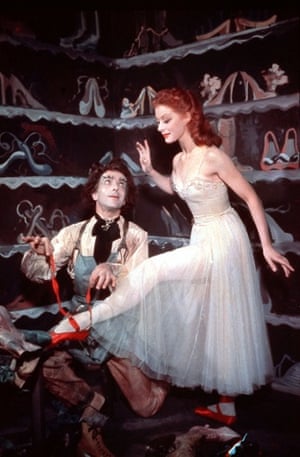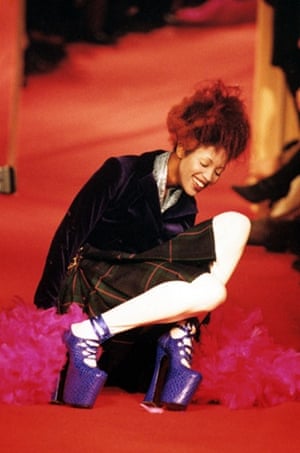It’s a bit like that in real life too. The fashion for wearing ballerina slippers as streetwear, which crested a couple of years ago, appeared to offer the pleasing possibility of skipping insouciantly through summer, rocking an Audrey Hepburn or Amy Winehouse vibe. But anyone who has tried wearing ballet flats all day, whether in Cannes or Camden, will know that they are not adapted to pavement living. Every single bit of grit makes itself felt through the flexible soles, so that after a couple of hours you start to resemble another of Andersen’s heroines, the Little Mermaid, whose every step cut her feet to bloody ribbons.
It is this knife-edge walk between pleasure and pain that forms the throughline of the V&A show. Taken together, the 200 pairs of shoes and boots on display comprise an inquiry into the oddly powerful place footwear occupies in our individual and collective psyche (it would be hard to imagine the museum staging an exhibition about blouses, say, or skirts). Nor is this a subject that matters only to women. Men are well represented here, as fetishists and makers (which, you can’t help thinking, sometimes amounts to the same thing), but also as wearers. So, along with Empress Eugénie’s fur bootees and a pair of crystal evening shoes from Christian Dior the colour of pink champagne, you will find Oxford brogues, Wellington boots and some six-inch-high platforms from the glam rock era that were used, according to the anonymous original owner, to “kick the shit” out of anyone who got in the way of a good night out in 1973.

This tumbling together of the material and the metaphoric is evident too in the history of the bathhouse clog. Originally designed by the Romans to keep their feet clear of other people’s soapy scum, the ancient clog travelled the known world, slimming down and picking up status as it went, much like this season’s unfeasibly fashionable “pool sandal” (Christopher Kane is doing some lovely ones for £300 a pop). In the Ottoman empire the clog came to rest as the ceremonial Qabâqib, best described as slip-on stilts. The Qabâqibs in the exhibition are nearly a foot tall, inlaid with mother of pearl, and were worn by a wealthy young woman during her wedding ceremony, which partly took place in the hammam. The effect must have been to turn the bride – naked on top of her preposterous pedestal – into a living statue.
Posing, it turns out, is what many of the shoes in this exhibition are all about. The grand parade of skyscraper heels, needle-point toes and clunky buckles is designed to make the point that useful activity, let alone manual labour, is pretty much impossible if you opt for statement footwear. The Indian princeling in possession of slippers with toes that curl and twist like smoke, and the Venetian lady tottering in her 21-inch-high chopines were sending a message that they relied on other people to do their dirty work for them. While the Maharaja and the Comtessa lounge around in their grandiose kicks, an army of slippered servants scurries about cooking, cleaning, filing and wiping infant noses.
Yet such gestures of dramatised dependency turn out to be only half the story. Another section of the exhibition is dedicated to the feeling of power that a set of manageably high heels can provide. In Qing dynasty China, for instance, women from eminent Manchu families wore richly embroidered shoes with a six-inch elevation that hoisted them far above the shorter Han women with their tiny bound feet. Not only did this lead to a sense of pleasing superiority, but it also allowed Manchu women to place themselves firmly in men’s sightlines. In ancient Greece a similar spirit of competition was in evidence when women attempted to follow the example of various stone Aphrodites by opting for thick-soled footwear. Their real intention, suggested the satirists, was to make sure they stood out in a crowd.
The commentators may have been right. Some women say they feel “powerful” in heels, others feel “sexy”. In truth, it can be difficult to parse the difference between the two. But that’s the great thing about shoes – they refuse to be pinned down to a single, reductive reading, insisting instead on bouncing up again as if made entirely of cork. Hence the way that so many of the shoes in this exhibition manage to be both legitimate and wayward, serious and slutty at the same time.

That moment of hypersexuality has passed, and we are now in the middle of a season of the so-called “ugly shoe” – flat, utilitarian and, like as not, a variation on something sensible that you were forced to wear at the age of eight. (It is for that reason that the dress code at Cannes this year made its odd stipulation about women having to wear heels on the red carpet: clearly there was a panic that people would turn up looking like they’d come straight from the beach.)
But if hooker chic is taking time off, there is no shortage of enthusiasm among avant-garde makers for exploring the extreme shapes into which the shoe – and the foot inside it – can be pushed and pulled. These days you’ll find Zaha Hadid applying her knowledge of complex structures to build a cantilever system that allows her “Nova” shoe to sport a surprisingly comfy six-inch heel. Dominic Wilcox has designed a prototype shoe that incorporates a GPS device into its heel. When you want to go home, all you have to do is click your heels together, like Dorothy in The Wizard of Oz. Alexander McQueen, meanwhile, has bequeathed us his “Armadillo” booties, which transform the wearer into a mutated superhuman, much as Noritaka Tatehana’s vertiginous take on the “geta” – the sandals worn by geisha – recently transformed Lady Gaga and Daphne Guinness into creatures from some strange new vision of the floating world.

Naomi Campbell falling over at the Vivienne Westwood fashion show, Paris in 1993. Photograph: News (UK) Ltd/Rex Features
Knowing this stuff in theory and living it out in practice are, of course, different things. The exhibition ends by trying to understand why some women, and a few men, build up vast collections of shoes that they are unlikely to ever get round to wearing. It can’t be with any hope of making a profit: even the most spectacular pair of strappy Ferragamos do poorly at auction in comparison with a vintage Chanel suit or a Schiaparelli skirt. The pleasure seems to come from looking and touching. “Guya”, for instance, has a pair of Céline mink-fur pumps that are so precious that they can never leave the house. Another collector, who stores her shoes on bookshelves in her bedroom reports happily: “The first thing I see every morning are my shoes.” “Jeff”, meanwhile, is a sneaker-head with more than 1,000 pairs, who explains how hard it is becoming to maintain his collection’s individuality now that there are so many fanatics chasing each new limited edition. Other collections, meanwhile, turn out to be patterned by repetition rather than grand design. The exhibition contains a sample from Imelda Marcos’s legendary stash, and the great surprise here is how wedded the former first lady of the Philippines was to a serviceable mid-heel in neutral colours.
